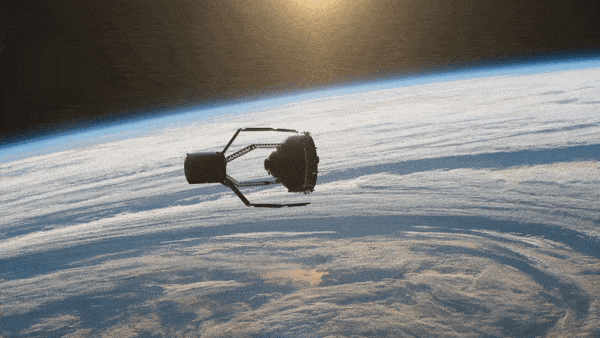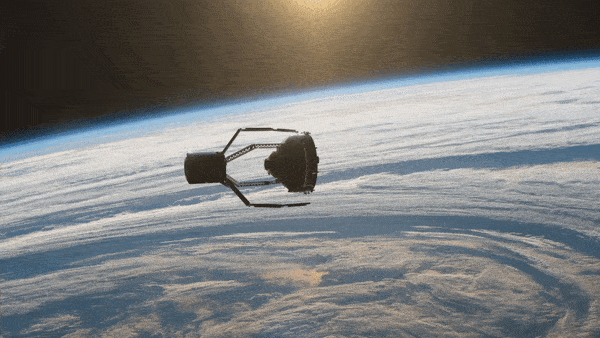
The recent fall to Earth of a massive Chinese rocket has renewed concerns about the perils of space junk and one project from the European Space Agency might be able to help.
The European Space Agency (ESA) announced plans to launch a space debris removal mission in 2025 with the help of a Swiss start-up called ClearSpace. The mission, dubbed ClearSpace-1, will use an experimental, four-armed robot to capture a Vega Secondary Payload Adapter (Vespa) left behind by ESA’s Vega launcher in 2013. The piece of space junk is located about 500 miles (800 kilometers) above Earth and weighs roughly 220 lbs. (100 kilograms).
“Think of all of the orbital captures that have occurred up until this point and they have all taken place with cooperative, fully-controlled target objects,” Jan Wörner, ESA Director General at the time, said in a December statement from the space agency. “With space debris, by definition no such control is possible: instead the objects are adrift, often tumbling randomly.”
Related: 7 wild ideas to clean up space junk
ESA recently signed a $104 million (€86 million) contract with ClearSpace to accomplish this feat. The team will use the ClearSpace-1 robot to capture Vespa from low Earth orbit and drag it down into Earth’s atmosphere, where both spacecraft will burn up. If all goes according to plan, the mission will be the first removal of a previously generated piece of space debris from orbit, according to the statement.
“This first capture and disposal of an uncooperative space object represents an extremely challenging achievement,” Wörner said in the statement. “With overall satellite numbers set to grow rapidly in the coming decade, regular removals are becoming essential to keep debris levels under control, to prevent a cascade of collisions that threaten to make the debris problem much worse.”
Low Earth orbit is cluttered with debris, ranging from inactive satellites to the upper stages of launch vehicles and discarded bits left over from separation. These pieces of space junk move at tens of thousands of miles per hour and could collide with and cause damage to active satellites and spacecraft in their path.
“At orbital velocities, even a screw can hit with explosive force, which cannot be shielded against by mission designers; instead the threat needs to be managed through the active removal of debris items,” Luc Piguet, founder and CEO of ClearSpace, said in the statement. “Our ‘tow truck’ design will be available to clear key orbits of debris that might otherwise make them unusable for future missions, eliminating the growing risks and liabilities for their owners, and benefitting the space industry as a whole. Our goal is to build affordable and sustainable in-orbit services.”
This is the first time ESA has paid for a service contract such as this instead of directly procuring and running the entire mission. The space agency says that this new way of business is the first step in establishing a new commercial sector in space, according to the statement.
In addition to the contract with ESA, ClearSpace will rely on commercial investors to cover mission costs. As part of ESA’s Clean Space Initiative and Active Debris Removal/ In-Orbit Servicing project (ADRIOS), the space agency will provide essential technologies, including advanced guidance, the robotic arms, navigation, control systems and vision-based AI, which will allow ClearSpace-1 to grapple its target autonomously.
Vespa is a reasonable first target for ClearSpace-1 given it is a relatively simple shape, sturdy construction, and about the size of a small satellite. If all goes according to plan, the team can leverage the same technology to capture larger, more challenging pieces of space debris in future missions. The team plans to first test ClearSpace-1 in a lower orbit of about 310 miles (500 km), prior to launching the mission to capture Vespa in 2025.
“The plan is that this pioneering capture forms the foundation of a recurring business case, not just for debris removal by responsible space actors around the globe, but also for in-orbit servicing,” Luisa Innocenti, head of ESA’s clean space office, said in the statement. “These same technologies will also enable in-orbit refuelling and servicing of satellites, extending their working life. Eventually, we envisage this trend extending into in-orbit assembly, manufacturing and recycling.”
Follow Samantha Mathewson @Sam_Ashley13. Follow us on Twitter @Spacedotcom and on Facebook.



